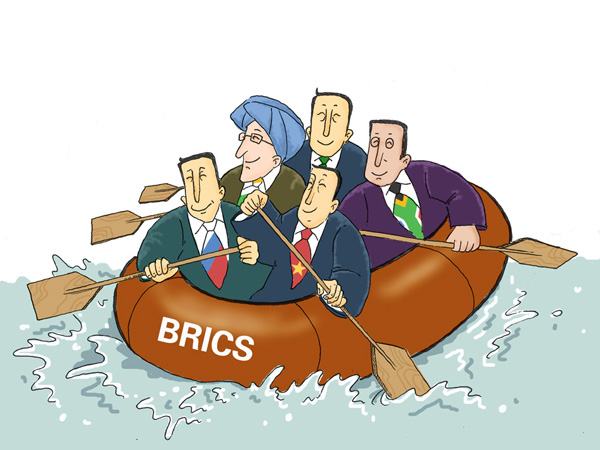'Broken BRICS' argument lacks vision, substance
 0 Comment(s)
0 Comment(s) Print
Print E-mail Xinhua, July 15, 2014
E-mail Xinhua, July 15, 2014
|
[By Zhai Haijun/China.org.cn] |
The familiar argument predicting a collapse of BRICS countries by the West has sadly failed to grasp the essence of the dynamic grouping from the emerging world.
Originally coined by the Goldman Sachs economist Jim O'Neil in 2001, the acronym referring to Brazil, Russia, India, China and South Africa used to stand for the great economic powers of the future, but many Western observers have recently come to question its unity and vitality after the five economies confronted headwinds in recent global economic downturn.
The worries from global investors looking for short-term profits are not totally unfounded, as most of the BRICS countries have witnessed a slowdown in their economic growth.
However, that temporary difficulty of the BRICS members has in no way changed the long-term prospect of a robust "rise of the rest," compared with the anaemic growth in the developed world, particularly since the financial crisis in 2008.
The BRICS countries, collectively representing almost 42 percent of world population, a quarter of global income and 17 percent of world trade, are gradually maturing and changing gear in their growth rates.
Their current slowdown is structural and cyclical in nature, and essentially healthier than a prolonged growth spurt driven by cheap credit and commodity exports.
China, for example, is upgrading its economic structure in order to achieve sustainable growth in the long run. Instead of clinging on to an exports-led, debt-fueled growth model, Beijing is carrying out major economic and political reforms to encourage a more consumption-led growth model.
Western investors are wary of risks in the emerging markets as the BRICS graph seems to be on a downward trend. But Western politicians are certainly aware of the negative spillover effects of their economic policies on the rest of the world.
The global financial crisis since 2008 has caused a nosedive in external demand, while a post-crisis America is pondering an exit of its massive quantitative easing measures, which could cause an abrupt capital flight paralyzing emerging market economies.
It is such internal needs for adjustment and external headwinds that make the BRICS economies in the short term a less lucrative investment option than before. But nobody in the world seems to have any doubt about their promising future in the long run.
Perhaps more important than GDP growth figures is the political unity behind BRICS' economic cooperation. As major players in Asia, Africa, Europe, and Latin America, their sheer size and population, political influence and ambition to play a responsible role in the international community make the five nations strong representatives of the developing world, which is showing growing prominence in an increasingly multipolar world.
The BRICS countries have already set up cooperation mechanisms such as a business council and a think-tank council, and is soon announcing the establishment of a development bank and a contingent reserve arrangement, which are meant to ensure short-and-longer term financial assistance amongst themselves.
Such substantial steps are not overlooked by the West. But the West is perhaps reluctant to admit the growing political unity of developing countries, which might become a counterweight to established powers in the West.
Focusing on economic, trade and development issues, the BRICS cooperative mechanism has the will, confidence and ability to inject a new momentum into their respective growth, taking advantage of their huge domestic markets and sufficient labor supply.
As strategic pivots of their region, the five-nation cluster will also strive to contribute to world peace and prosperity by pushing for global governance reforms in such aspects as the international financial and monetary system, climate change and regional issues.
It is such a broad vision that brings the BRICS together, and that gives the grouping a brighter future.







Go to Forum >>0 Comment(s)